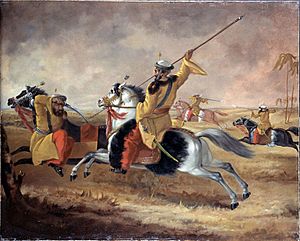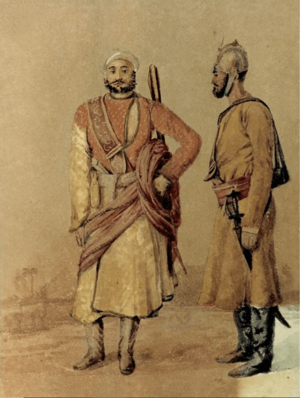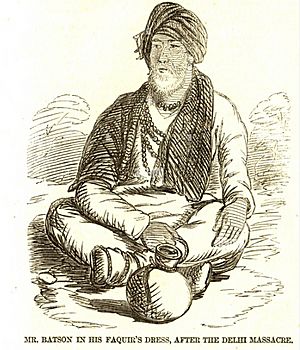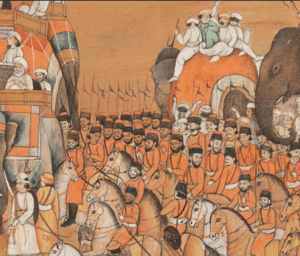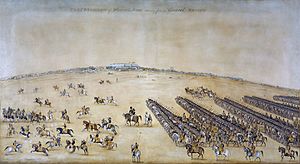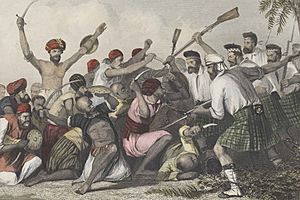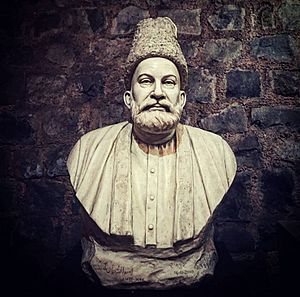Indian Muslims in the 1857 Rebellion facts for kids
The Indian Rebellion of 1857, also known as the Sepoy Mutiny, was a major uprising in India from 1857 to 1858. It was against the British East India Company, which ruled India for the British government. The rebellion started on May 10, 1857, when sepoys (Indian soldiers) rebelled in Meerut, a town near Delhi. It quickly spread across many parts of northern and central India.
Many Muslim soldiers, called sepoys, helped start the rebellion. They were upset by rumors that the cartridges for their rifles were greased with animal fat, which went against their religious beliefs. In areas like Awadh, Delhi, Bihar, and Bengal, Muslim leaders played important roles in the uprising. Famous figures like Bahadur Shah II, the last Mughal emperor, and Maulvi Ahmadullah Shah led big revolts against the British. They hoped to bring back Muslim political power.
Contents
Why the Rebellion Started
Soldiers and Jobs
After Muslim rule ended, many Muslim horsemen lost their jobs. Some joined the East India Company's army in special cavalry units. These units kept old Mughal cavalry traditions. They mostly hired Muslim families from northern India, who made up about three-quarters of the British army's cavalry.
This helped keep many cavalrymen busy who might otherwise have caused trouble. However, not all of them could find jobs, and some didn't like the strict rules of the British army. Many became mercenaries or were unemployed, which made them unhappy. For many Indian Muslims, British rule meant losing their way of life and their jobs.
Family Loyalty
Some Indian Muslim families had served the Mughal emperors for many generations. They had a strong bond of respect with the throne. British rule did not create this same bond with its subjects.
For example, a man named Sayyid Ghulam Abbas, whose family had long served the Mughals, left the British army to join the Mughal Emperor. He felt it was his duty, even though the Emperor had little to offer him. The rebels saw themselves as "servants of the King of Delhi." They believed they were restoring the rightful rulers of India. They called the British "Baghi" (usurpers) who had taken power unfairly.
Religious Feelings
The role of religion in the 1857 rebellion has been discussed for many years. Early British reports suggested that religious complaints were the main reason for the mutiny. The new Enfield Rifle cartridges, rumored to be greased with animal fat, were seen as an insult to Muslim and Hindu religions.
More recent studies, like William Dalrymple's book The Last Mughal, highlight the importance of religion. These studies use old Urdu writings that often call the British "Nasrani" (Christian) and "Kafir" (infidel) instead of just "Firangi" (European). It's important to note that British people who had converted to Islam were usually spared during the violence. However, Indian people who had converted to Christianity were often killed.
Key People and Groups
The Rebel Soldiers
Indian Muslims made up about 75% of the British Indian cavalry. Hindus made up 80% of the infantry. In the British Indian artillery, North Indian Muslims were often preferred and formed most of the force. This was because, unlike Hindus, Indian Muslims were generally willing to fight overseas.
The cavalry soldiers of the 3rd Native Cavalry were mostly Indian Muslims. They were the first to rebel in Meerut, which started the war. These soldiers rode from Meerut to Delhi to make Bahadur Shah II the leader of the rebellion. While they kept some of their British army training, Indian Muslim military groups often wore Islamic clothes to show they were different from the loyal soldiers.
The Leaders
Bahadur Shah II was at first surprised by the rebellion. But he was convinced to hold a durbar (a royal court meeting) to show that the Mughal Empire was back. A new set of rules, called the Dastarul Amal, was created. Bahadur Shah II gave positions to his sons and relatives. He also wrote letters to other rulers, asking them to join his fight against the British. A committee was formed to manage the army and government.
While Bahadur Shah later claimed he was unwilling, some accounts say he became more involved in leading the troops in Delhi. His growing support for the uprising, even if it wasn't always strong, changed the whole nature of the rebellion.
One of Bahadur Shah's sons, Mirza Mughal, had been in contact with unhappy soldiers since 1856. From May 12 onwards, he became a main rebel leader in the royal family. He worked hard to keep the Delhi government running during the chaos. He was made commander-in-chief of the first rebel soldiers and tried to organize them. Mirza Mughal built many barricades and defenses in the city streets. He wanted to trick the British into fighting inside the city, where they would be less safe.
Another important leader was Bakht Khan. He was elected general by the troops from Bareilly and arrived in Delhi. He was known as a good administrator and a strong military leader.
Local Lords
The rebellion in Meerut quickly spread across northern India. The uprisings often followed a similar pattern. In Muzaffarnagar, Khaitati Khan Pindari led the revolt. He even captured a fort. In Thana Bhawan, Inayat Ali Khan led the Muslim uprising.
In Aligarh, Ghiyasuddin Muhammad Khan led a strong Muslim rebellion. He raised a green flag and declared himself a ruler in the name of the King of Delhi. He collected taxes and acted like a king. He had thousands of fighters, including soldiers and local villagers. In Saharanpur, local people rebelled even before the soldiers mutinied. Many Muslims and other groups joined the revolt when they heard about the Meerut uprising and the fall of Delhi.
Religious Fighters (Ghazis)
British reports mention green religious flags that were used to call people to fight. These flags were a symbol against the British army's flags. One description of a ghazi (religious fighter) force said they wore "thick quilted tunics of green silk...with green turbans." They carried round shields and curved swords. British sources said the ghazis were "far more difficult to deal with than mutinous sepoys."
Ahmad Allah Shah, a religious leader from Faizabad, was a natural leader. He troubled the British forces during their campaign to conquer Awadh in 1858. Other religious leaders also led revolts in different towns. Some Ghazis were even British people who had converted to Islam. One such person, Sergeant Gordon, fought against the British.
After the Rebellion
In areas where Muslims clearly took part in the Mutiny, like Delhi, British leaders often saw a strong Muslim influence in the rebellion. The Urdu poet Ghalib wrote about the widespread violence.
After the rebellion, the British often described Muslims as very religious and easily angered. They saw them as a united group who were aggressive and disloyal. For example, John Lawrence, a British official, wrote that "The Mahomedans...have displayed a more active, vindictive, and fanatic spirit than the Hindoos."
On the other hand, Sayyid Ahmad Khan, an Indian Muslim leader, argued that Hindus were the main ones who started the rebellion. He said that Muslims were innocent and had the most to lose from the war.


